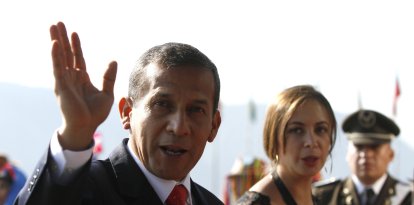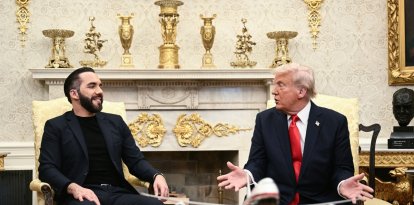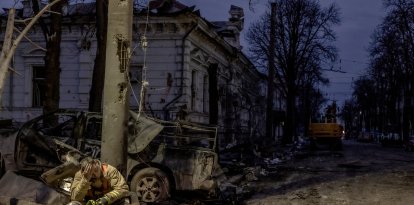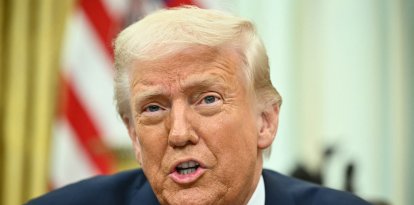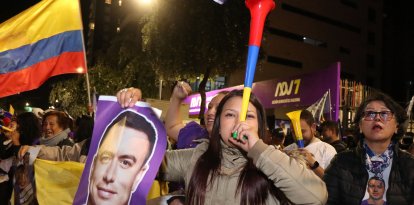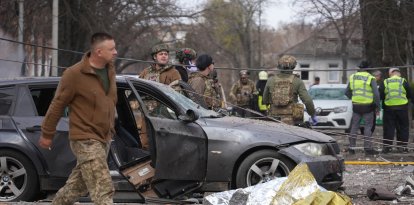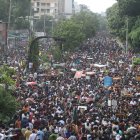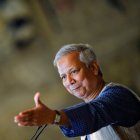Bangladesh: how the student revolution that brought down Sheikh Hasina's regime led to a wave of violence against the Hindu minority
From fierce repression by the authorities, to persecution that threatens the safety of Hindus, who barely represent 8% of the population.
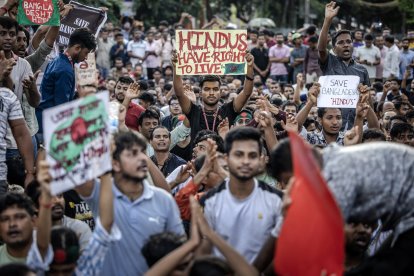
"Hindus have the right to live," reads a placard held by a Hindu protester in Bangladesh
In an act of protest on Friday, August 9, hundreds of people took to the streets in Bangladesh's capital, Dhaka, to take a stand against violence selectively targeting the country's Hindu minority after former Prime Minister Sheikh Hasina resigned and fled the Asian country earlier this week.
Hasina left the country amid a student revolution that suffered a fierce crackdown over the past two months, especially in recent weeks. While there are no official figures, it is estimated that more than 400 people were killed during the rebellion, many of them killed by the repression of the forces of order, who were ordered to use bullets to repress.
The situation, which generated a climate of instability for several weeks, eventually escalated to the point where hundreds of thousands of Bangladeshis came out to protest and demanded Hasina's resignation for weeks. Eventually, the military stopped repressing, siding with the protesters and Hasina had to flee the country, settling for the time being in India and thus ending her 15-year rule plagued by corruption scandals, accusations of suppression of free speech and persecution against political dissent.
The problem is that, after embracing freedom, some radical Islamist groups, which were part of the dissidence, allegedly launched a counter-offensive against Hindus, who in Bangladesh barely represent 8% of a population of 170 million inhabitants. This situation has led to a wave of violence that today alarms the international community, members of the transitional government in Bangladesh and is going largely unnoticed around the world.
But how did we get to this point? Here is the chronology:
This is how the revolution in Bangladesh came about.
In conversation with VOZ, Max Povse, professor and member of the Asian and Latin American Studies Group at the University of Buenos Aires, explained that the Bangladeshi student movement, dubbed 'Students against Discrimination', was initiated by a trick of the Supreme Court of the Asian country that wanted to reimpose a system of employment quotas in the civil service. This policy especially benefited the families of veterans of the 1971 war of independence against Pakistan.
Critics claimed that this system, instead of being based on ability and merit, only benefited members of Hasina's party, the Awami League; a party that advocates the secular state and was founded in 1949 by Sheikh Mujibur Rahman, Hasina's own father.
In doing so, the Supreme Court ordered the overturning of a 2018 decision by Hasina's government that had eliminated the ever-controversial quotas, generating the start of demonstrations on university campuses in June, Povse detailed.
Over time, the protests took on increasing force, sparking clashes between law enforcement and protesters. In July alone, about 150 people were killed due to demonstrations and repression. In August, that number doubled between Sunday and Monday, with hundreds killed as a result of the intense law enforcement response.
Hasina, instead of calming tempers at the time, stoked the tension by saying that "those who are carrying out the violence are not students, but terrorists seeking to destabilize the nation." In addition, the former prime ministerrepeatedly cut internet access in some parts of the country and imposed a nationwide curfew.
"We have to look out for ourselves and our future generations. We need jobs in this country, we are already suffering from the lack of it," Alam Rashid, a student from Dhaka, told The Independent. "We have invited the government to have a conversation with us multiple times, instead she [Sheikh Hasina] just unleashed her police force on us."
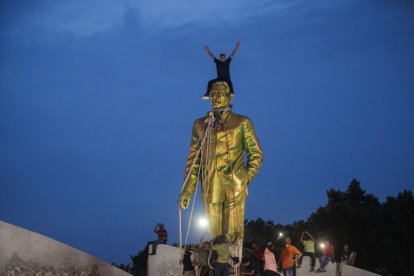
Protesters climb a statue of Sheikh Mujibur Rahman, founding father of Bangladesh and Sheikh Hasina's father.
There was a moment where the protests might have calmed down, last July 21, when the Supreme Court made the decision to remove most of the employment quotas. However, the students, who had already been joined by hundreds of thousands of Bangladeshis, seized on the momentum behind the protest to make their demands now general against Hasina. Everything escalated until the call for her resignation was massive, a product of outrage over the bloody crackdown.
"It’s not [just] students anymore, it seems that people from all walks of life have joined the protest movement," Dr. Samina Luthfa, assistant professor of sociology at Dhaka University, told the BBC in July.
The economic, employment and political context also motivated the protesters. Despite Bangladesh becoming one of the fastest growing economies in the world thanks to garment exports, the lack of private sector employment, coupled with serious allegations of corruption and strong incentives to enter the civil servicegenerated a climate of considerable internal instability; with millions of unemployed youth, rampant inflation hovering around 10% per annum and a dwindling dollar reserve.
How was Hasina ousted and how was the transitional government formed?
Over the past weekend, attacks and pockets of protest were reported across Bangladesh. There were no longer only peaceful demonstrations,but also incidents of vandalism and arson against government buildings, Awami League offices, police stations and homes of well-known public officials. According to The Independent, in total, clashes were reported in 39 of 64 districts across Bangladesh.
Sunday was particularly savage, being one of the deadliest dates of the demonstrations, with at least 95 killed between protesters and police officers. On Monday, the situation went to another level, with the big "March to Dhaka", called by the student coordinators of Dhaka University.
This march was in response to the crackdown by the authorities, after the military issued an ultimatum to the students to abide by the curfew. The situation led to massive clashes in the capital, leaving 135 people dead, but one major success: the takeover of the Bangladeshi capital. This forced the military to call on Hasina to resign after top commanders refused to order further repression.
Hasina's departure generates a debate on legacy and her actions as ruler, relatively linked to stability, economic growth and infrastructure development. However, in the face of that fact contrasts corruption and human rights violations, including heavy restrictions on freedom of expression and intolerance of dissent.
Already without Hasina, the head of the Bangladesh Army, General Waker-uz-Zaman, took control and announced a loose plan to form an interim government in the country. Days later, Nobel laureate in economics, Muhammad Yunus, renowned for his micro business loans to people in poverty and also politically persecuted during Hasina's regime, became the head of the interim government at the request of student leaders.
"Given the sacrifices of the students, especially those who have lost their lives for our nation’s liberation, I am not in a position to say no to them (...)In the coming days, I will talk with all of the relevant parties about how we can work together to rebuild Bangladesh and how they can help (...) I have no intention to seek any elected or appointed office beyond this role during this interim period."
It also ordered the release of jailed former prime minister Khaleda Zia, one of the leaders of the opposition Bangladesh Nationalist Party (BNP), along with student protesters. The BNP boycotted elections in 2014 and 2024, claiming there were no conditions to fairly contest while Hasina was in power. This party always advocated for an election to be held under a neutral transitional administration, a real possibility due to the current situation.
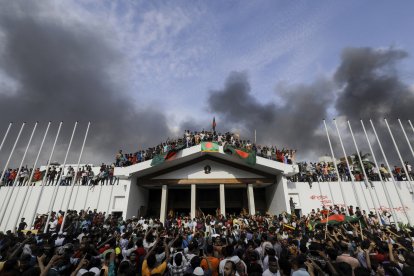
Protesters display the Bangladesh flag as they seize Sheikh Hasina's palace in Dhaka on August 5.
From revolution, to violence against a minority
At the time of publishing this article, the situation in Bangladesh is much calmer compared to the first hours of institutional crisis after Hasina fled the country, Professor Povse told VOZ.
The arrival of Yunus, who has sent constant messages of calm, has generated some stability and consensus while the transition and elections are being negotiated.
However, after the revolution, there were Dantesque images, which were largely ignored by the press and which also generated moments of misinformation on social networks, such as old videos about gang rapes that did not occur in Bangladesh in the last week.
According to a report in The New York Times, thousands of Hindu Bangladeshi citizens, perceived supporters of Hasina and the Awami league, began to suffer a wave of savage violence by Islamist extremist groups.
"Sheikh Hasina, fled Bangladesh on Monday after a violent crackdown failed to quell a nationwide movement against her government. As thousands of protesters celebrated her ouster that afternoon, reports began to emerge of retaliation against members of Ms. Hasina’s party, the Awami League, and against those seen as her allies, including the Hindu minority," the NYT reported.
According to local media accounts and also witnesses, violent protesters attacked Awami League offices, the homes of its members, and properties of Hindus, setting fire to their homes and vandalizing temples.
Prionthi Chatterjee, a Hindu student in Dhaka, told the NYT that violent protesters attacked her family at their home in the Bagerhat region. Her father was killed and her mother was left with head injuries.
"My father was an innocent teacher," said Chatterjee, who said they tried, with no luck, to call the army and police for help.
In addition to the personified violent attacks against Hindus, vandalism against Hindu homes and temples was also reported in at least four districts of Bangladesh, including villages near Chattogram, the country's second most populous city,
Rana Das Gupta, leader of a religious minority organization in Bangladesh, claimed that the attacks on Hindus left at least two dead and more than 100 injured. Although these figures were not independently corroborated by VOZ and other media, such as Reuters, report that there was one death and more than 40 injured.
"Some of those whose homes were attacked may be directly involved in Awami League politics, but most are ordinary Hindus," Das Gupta said. "Therefore, this is definitely communal and targeted violence."
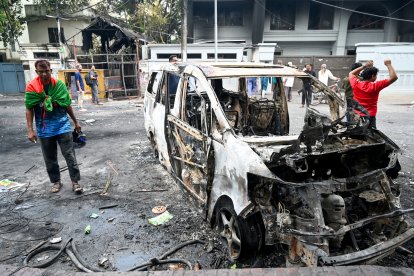
A burnt car in front of the office of the Awami League party, party of ousted Sheikh Hasina.
Povse confirmed that the acts of violence are real, although a lot of misinformation is also running on social networks. The professor and member of the Asia and Latin America Studies Group of the UBA also told VOZ that the situation was so Dantesque that even students who led the movement against Hasina "had to call for peace and defend Hindu temples" in the face of the advance of the most radical Islamist groups that oppose the Awami League.
Nahid Islam, one of the student leaders who organized the mass protests, also denounced the attacks on Hindus assuring that they were most likely attacks by people outside the student movement.
"Temples are being attacked, vandalized and looted," Nahid Islam said.
Now, after hundreds were injured, Hindus decided to take to the streets to demand respect and an end to the violence in the capital Dhaka.
The Hindu, Buddhist and Christian Unity Council of Bangladesh, which estimates that at least 52 of the country's 64 districts were affected by communal violence since Aug. 5, called on Muhammad Yunus for help.
"There is deep apprehension, anxiety and uncertainty among minorities across the country," the council said in an open letter Friday.
Meanwhile, the international community, aware of the situation, has also called for respect for the Hindu minority.
In particular, Indian Prime Minister Narendra Modi called for the "safety and security" of Hindus and other minorities in the Asian country as thousands of Bangladeshi Hindus are trying to flee to neighboring India for fear of violence.
Many Hindus feel the worst could be yet to come,as they believe a radical Islamist government would have no qualms about persecuting them, escalating violence against them motivated by a certain thirst for revenge following the climate of the past few months.
"We appreciate the interim government, but how long will it last before the radicals take over?" 46-year-old Sheeba Pal, who headed to Haridaspur, India, told The Independent following the wave of violence recorded in the past week.
RECOMMENDATION
